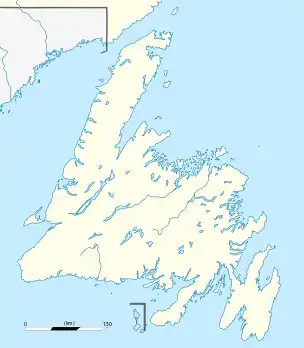New Harbour, Newfoundland and Labrador
New Harbour, is a community on the East shore of Trinity Bay, located along Provincial Route 80; Route 80's intersection with Route 73 is inside New Harbour, in the Canadian province of Newfoundland and Labrador. The population was 491 in 2016 .
New Harbour | |
|---|---|
Local Services District | |
 New Harbour | |
| Coordinates: 47°35′10″N 53°32′26″W | |
| Country | |
| Province | |
| Census division | Division 1 |
| Census subdivision | Subdivision E |
| Government Governed by Committee of volunteers | |
| • Type | Local Service District |
| • Chairperson | Clifford Pollett |
| Area | |
| • Total | 3 km2 (1 sq mi) |
| Population (2016) | |
| • Total | 491 |
| Time zone | UTC-3:30 (Newfoundland Time) |
| • Summer (DST) | UTC-2:30 (Newfoundland Daylight) |
| Area code(s) | 709 |
| Highways | |
Going as far back as 1800, it was a major ship building center.
In the past, the railroad served to provide the transportation of paper from the Grand Falls Mill to Heart's Content, for shipping to foreign markets.
Business
New Harbour has two bakeries, Harnum's Bakery, located on Harbour Drive, and Pitcher's Bakery, located on Route 80, which also has a gas station and take out.
At one point there was a pharmacy that shared a building with a flower shop and a general practitioners office, but as of the end of 2017, all three businesses have since closed down. New Harbour also has a new Dental Office and Day Care Center which share the same building.
The Inside Scoop Country Store is located on Westside Road. This store offers a wide range of bulk foods, spices, specialty coffees, wine making kits and supplies, local artisan wares, local literature, and ice cream.
Jackson's Castle Building Supplies is located on Main Road (Route 80) in New Harbour
H&B Construction in New Harbour contracts varied industrial and commercial infrastructure construction.
Sapphire Salon is located on Main Road (Route 80) in New Harbour
Hidden Beauty Salon is located on Main Road (Route 80) in New Harbour
Quinn Sea Lobster Facility is located on Fish Plant Road (off West Side Drive)
Woodhaven Cottages in located on New Harbour Barrens (Route 73)
Island Pond RV Park is located on New Harbour Barrens (Route 73)
No Charge For the View B&B is located on Newhook's Hill in New Harbour
History
New Harbour was first settled by Europeans, during the mid-1700s. Various families settled in New Harbour, each in its own Room; (a Room is a few acres of land where sons, grandsons etc. all built their homes). For example, Thornes' Room fronts on the Pond; generations of Thornes have built homes on the nearby lands. Earlier family names include Pitcher, Williams, Newhook, Higdon, Woodman, Pollett, Cranford, Hillier, Hefford, George, Thorne. The people of New Hr. have made livings from industries such as Fishing, Shipbuilding, the Pothead Drive, Hunting, Mink Ranching, Farming and from Working Seasonally, in distant places.
Shipbuilding
Going as far back as 1800, or perhaps before that, the Newhook Family, led by Master Shipbuilder Charles Newhook (first) were noted as being Newfoundland's greatest family of shipbuilders. Charles Newhook (second) moved to New Harbour from Trinity, also in Trinity Bay around 1806 to become master shipbuilder and leading inhabitant. From that point in time up to the early 1900s, New Harbour was a premier site for shipbuilding. [1]
Anderson's Cove Archaeological Site
Long before the arrival of the Dorset Eskimo, Newfoundland was home to an Indian people known to us as the Maritime Archaic. The first people to live in Newfoundland, the Maritime Archaic Indians arriving on the island about 5000 years ago and seem to have disappeared around 3200 years ago. In the summer of 1993, Dr. Paul Bonisteel, a resident of New Harbour, was walking in Anderson's Cove, located about a mile (1.6 km) northeast of Dildo Island between the communities of New Harbour and Dildo, when he discovered a large Maritime Archaic stone axe eroding from the bank above the beach.
In the fall of 1995, the BTHC undertook an archaeological survey of Anderson's Cove and in 1996 some preliminary excavations were conducted. Fragments of stone tools and flakes were found scattered over a large area but no camp site was discovered. It may be that there is an Archaic camp site at Anderson's Cove and it has yet to be discovered. On the other hand, it is possible that the camp has been washed into the sea over the more than 3000 years since the site was abandoned. While none of the artifacts found at Anderson's Cove allow us to say when the site was first occupied, a Maritime Archaic spear point found in Collier Bay, roughly 6 miles (9.6 km) to the west of Anderson's Cove, dates to about 4500 years ago and it seems likely that Anderson's Cove was occupied around the same time.[2]
Contamination at landfill site
A concern in New Harbour since the late 20th century is contamination with polychlorinated biphenyls (PCB) on the landfill site on the New Harbour barrens.[3] These are located inside and perhaps in part near to New Harbour. This issue leads to other concerns, namely public health, environmental health and animals' health. People have been taking items such as copper,oil and perhaps and others for reuse from the exposed PCB-containing transformers casings at the landfill — at the time unaware of the dangers of the PCBs. A main trigger or cause for the problem was that in 1994, the PCB containing transformer casings were stored in Makinsons, Newfoundland and Labrador. They were allegedly,and very probably inadequately cleaned/treated for the PCBs, but still transported to the New Harbour barrens landfill. This has triggered the above-mentioned concern, and some actual harm for the health of the surrounding environment and life. Some state that the New Harbour landfill have mutant rats the size of dogs. However, some evidence has come to light, that PCBs and of course PCB-containing transformers were transported to the landfill site, likely illegally. This may include and be backed up by the fact that the number of transformer casings found at the landfill after 1994 exceeds by far the numbers transported from Makinson's to the landfill in 1994. So more casings were obviously put there, likely before 1994. Efforts are being made by residents to have the PCBs cleaned from the landfill, but may be fully unsuccessful at times,at least in response of investigation and cleanup,but replies are coming back to those who send request. In a recent year, a significant 24 percent increase was noted in environmental petitions from the last year, probably in part concerning this problem,but other very unrelated increasing concerns are a part of this petition increase as well.
First Nation and Inuit artifacts
At excavations like Anderson's Cove near New Harbour, evidence points to it being home to the Dorset culture, maritime archaic First Nations and the Beothuk people some thousands of years ago.[4][5]
St. Augustines's church
The Local church in New Harbour is St. Augustine's. It was constructed after the first church St. George's blew down in the 1880s.
References
- http://www.newfoundlandshipbuilding.com/earlyshipbuilding/newhooks/documents/the_newhook_family.htm
- https://web.archive.org/web/20120120003042/http://www.baccalieudigs.ca/andersons_cove.asp
- "Contaminated site in New Harbour, Newfoundland and Labrador". Office of the Auditor General of Canada. 1 October 2007.
- "New Harbour, Trinity Bay". Baccalieu Trail. Archived from the original on 2010-07-26.
- "New Harbour - Newfoundland and Labrador". Newfoundland and Labrador Tourism Information.
- Woodland Elementary. Eastern School District.
- Crescent Collegiate
